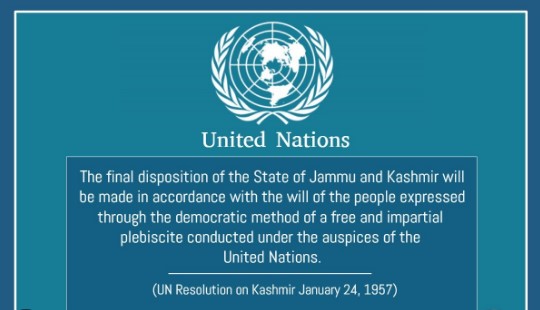|
Getting your Trinity Audio player ready...
|
United Nations Resolution on Jammu Kashmir

The Jammu & Kashmir conflict has long been a point of contention between India and Pakistan, leading to numerous wars, skirmishes, and diplomatic standoffs. This article explores the United Nations’ role in addressing this issue, focusing on its resolutions and their implications. Understanding the UN’s stance is crucial to comprehend the complex dynamics of this region and the ongoing efforts for peace.
UN Involvement
Early Requests for UN Mediation
Both India and Pakistan sought UN intervention to mediate the conflict. The United Nations Commission for India and Pakistan (UNCIP) was established to investigate and mediate the issue.
Establishment of the United Nations Commission for India and Pakistan (UNCIP)
UNCIP aimed to facilitate a peaceful resolution through negotiation, focusing on a ceasefire, withdrawal of forces, and a plebiscite to determine the region’s future.
-
Since 1948, the UN Security Council has remained seized of the Jammu & Kashmir dispute under the Agenda item “India-Pakistan Question” and passed over a dozen resolutions. A brief description of the important resolutions related to the J&K dispute is given below:
The resolution requests that the Security Council should be immediately informed of any material change in the situation in J&K.
The resolution established the UN Commission for India and Pakistan (UNCIP) to investigate and share facts with the Security Council about the situation in J&K.
The resolution rules that the question of the accession of Jammu and Kashmir to India and Pakistan should be decided “through the democratic method of a free and impartial plebiscite”.
Through this resolution, the Security Council emphasizes the need to resolve the dispute to maintain international peace and security.
The resolution reaffirms that the final disposition of the J&K dispute will be by the will of the people, expressed through the democratic method of a free and impartial plebiscite.
This resolution is significant as it pronounces that any determination of the final solution by the erstwhile Constituent Assembly in IIOJ&K would not constitute a disposition of the State of J&K, by the principles mentioned in UNSC resolutions.
Reaffirming that the question of accession of the State of Jammu and Kashmir to India or Pakistan would be decided through the democratic method of a free and impartial plebiscite conducted under the auspices of the UN, the resolution laid down the maximum number of troops to be maintained by both India and Pakistan at the end of the period of demilitarization before the plebiscite.
The resolution once again stipulates that any action that the Constituent Assembly in IIOJ&K may have taken or might attempt to take to determine the future shape and affiliation of the entire State of J&K and any part thereof, would not constitute a disposition of the State in accordance with the above principle
The resolution urges India and Pakistan to resume dialogue on all outstanding issues, particularly on all matters about peace and security, to remove tensions and encourages them to find mutually acceptable solutions that address the root causes of those tensions, including Kashmir.
UN COMMISSION FOR INDIA AND PAKISTAN (UNCIP) RESOLUTION (1948)
Under this resolution, both India and Pakistan have reaffirmed their wish that the future status of the State of Jammu and Kashmir shall be determined by the will of the people, and to that end, upon acceptance of the Truce Agreement, both Governments agree to enter into consultations with the Commission to determine fair and equitable conditions whereby such free expression will be assured.
The resolution states that the question of the accession of the State of Jammu and Kashmir to India or Pakistan will be decided through the democratic method of a free and impartial plebiscite.
Conclusion
The UN’s resolution on Jammu & Kashmir remains a significant yet unfulfilled effort to resolve the conflict. Both India and Pakistan need to prioritize dialogue and cooperation to achieve a peaceful and sustainable solution. The hope is that with continued diplomatic efforts and international support, a resolution can be reached that respects the rights and aspirations of the people of Jammu & Kashmir.
FAQs
What is the UN Resolution 47?
UN Resolution 47, passed in 1948, called for a ceasefire, demilitarization, and a plebiscite in Jammu & Kashmir to determine the region’s future.
Why has the UN Resolution not been implemented?
The resolution’s implementation has been hindered by disagreements between India and Pakistan, practical difficulties, and changing political dynamics.
How does the international community view the Jammu & Kashmir issue?
The international community has varied views, with some supporting India’s stance, others supporting Pakistan, and many calling for a peaceful resolution through dialogue.
What are the main obstacles to peace in Jammu & Kashmir?
Key obstacles include political disagreements, security concerns, historical grievances, and human rights issues.
What can be done to resolve the Jammu & Kashmir conflict?
The resolution requires sustained dialogue, confidence-building measures, international mediation, and addressing the humanitarian and political concerns of the region.
You can also Download PDF Files on All UN Resolutions on Jammu & Kashmir: Click HereThank you so much for your kindness and support! Warm regards


